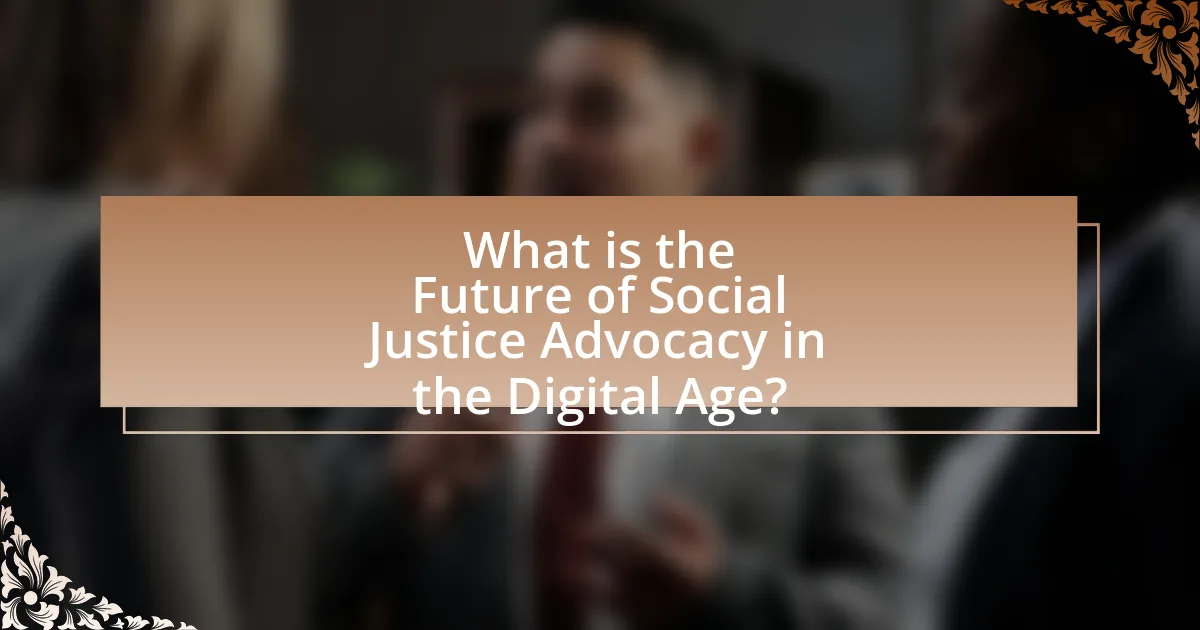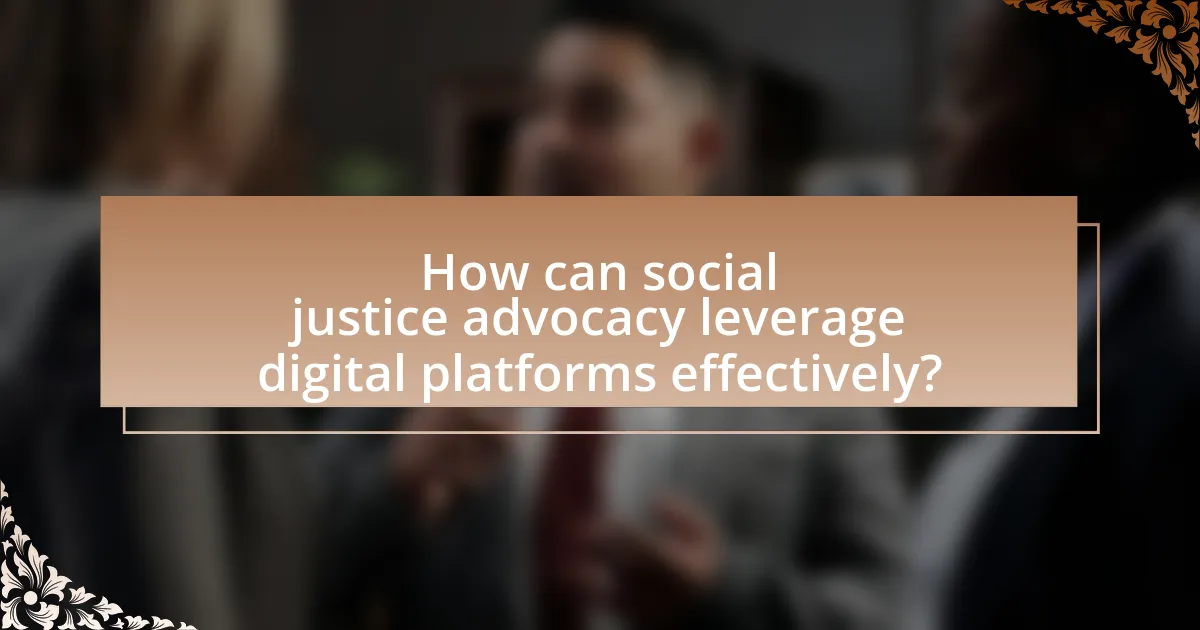The article examines the future of social justice advocacy in the digital age, highlighting the transformative role of technology and digital platforms in enhancing accessibility, mobilization, and awareness. It discusses how social media has been pivotal in movements like Black Lives Matter, enabling rapid information dissemination and community engagement. Key digital tools, including online petitions and crowdfunding, are explored for their effectiveness in supporting advocacy efforts. The article also addresses challenges such as misinformation and digital surveillance, while emphasizing strategies for successful online campaigns, the importance of collaboration, and the potential of emerging technologies like artificial intelligence and virtual reality in shaping future advocacy initiatives.

What is the Future of Social Justice Advocacy in the Digital Age?
The future of social justice advocacy in the digital age is characterized by increased accessibility, global reach, and the use of technology to mobilize support and raise awareness. Digital platforms enable activists to connect with diverse audiences, share information rapidly, and organize campaigns effectively. For instance, social media has played a crucial role in movements like Black Lives Matter, where hashtags and viral content have galvanized international support and prompted policy discussions. Additionally, data analytics and online tools allow for targeted outreach and engagement, enhancing the impact of advocacy efforts. As technology continues to evolve, social justice advocacy will likely become more integrated with digital innovations, fostering collaboration and amplifying marginalized voices.
How has digital technology transformed social justice advocacy?
Digital technology has transformed social justice advocacy by enhancing communication, mobilization, and awareness on a global scale. Social media platforms, such as Twitter and Facebook, enable activists to disseminate information rapidly, organize protests, and engage with a wider audience, thereby amplifying their messages. For instance, the #BlackLivesMatter movement gained international attention through social media, leading to widespread protests and policy discussions. Additionally, digital tools like crowdfunding platforms have facilitated financial support for various social justice initiatives, allowing grassroots organizations to thrive. According to a 2020 report by the Pew Research Center, 69% of Americans believe social media is an effective tool for raising awareness about social issues, highlighting its significant role in modern advocacy efforts.
What are the key digital tools used in social justice movements?
Key digital tools used in social justice movements include social media platforms, online petitions, crowdfunding websites, and mobile applications. Social media platforms like Twitter and Facebook facilitate rapid information dissemination and community mobilization, evidenced by movements such as Black Lives Matter, which gained traction through viral hashtags and posts. Online petitions, hosted on sites like Change.org, allow individuals to rally support for specific causes, with millions of signatures collected for various social justice issues. Crowdfunding websites like GoFundMe enable activists to raise financial support for initiatives and legal defenses, demonstrating the power of collective funding in social movements. Additionally, mobile applications provide resources and communication channels for activists, enhancing coordination and outreach efforts. These tools collectively empower individuals and organizations to advocate for social change effectively.
How do social media platforms influence public awareness of social justice issues?
Social media platforms significantly enhance public awareness of social justice issues by facilitating rapid information dissemination and fostering community engagement. These platforms allow users to share personal experiences, mobilize support, and amplify marginalized voices, which can lead to increased visibility for various social justice causes. For instance, the #BlackLivesMatter movement gained global traction through Twitter and Instagram, resulting in widespread protests and policy discussions. Research indicates that social media campaigns can lead to a 20% increase in public engagement on social justice topics, demonstrating their effectiveness in raising awareness and driving action.
What challenges do advocates face in the digital landscape?
Advocates face significant challenges in the digital landscape, including misinformation, digital divide, and data privacy concerns. Misinformation can undermine advocacy efforts by spreading false narratives, making it difficult for advocates to communicate their messages effectively. The digital divide creates barriers for marginalized communities, limiting their access to online resources and participation in advocacy campaigns. Additionally, data privacy concerns pose risks as advocates navigate platforms that may compromise the confidentiality of their supporters and sensitive information. These challenges hinder the effectiveness of social justice advocacy in the digital age.
How does misinformation impact social justice advocacy online?
Misinformation significantly undermines social justice advocacy online by distorting facts and creating confusion among supporters. This distortion can lead to misinformed actions, eroding trust in legitimate movements and hindering effective mobilization. For instance, a study by the Pew Research Center found that 64% of Americans believe misinformation has a major impact on public opinion, which can skew perceptions of social justice issues. Consequently, advocates may struggle to gain traction for their causes, as misinformation can overshadow critical messages and dilute the urgency of social justice initiatives.
What are the risks of digital surveillance for activists?
Digital surveillance poses significant risks for activists, primarily by compromising their privacy and safety. Surveillance can lead to the identification of activists, making them vulnerable to harassment, arrest, or violence from authorities or opposing groups. For instance, the 2011 Arab Spring highlighted how governments used digital surveillance to track and detain protestors, demonstrating the real-world consequences of such monitoring. Additionally, the collection of data on activists can result in targeted disinformation campaigns, undermining their credibility and efforts. The risks are further exacerbated by the potential for hacking and data breaches, which can expose sensitive information and strategies, ultimately jeopardizing the effectiveness of social justice movements.

How can social justice advocacy leverage digital platforms effectively?
Social justice advocacy can effectively leverage digital platforms by utilizing social media for awareness, mobilization, and community building. Social media platforms like Twitter, Facebook, and Instagram allow advocates to reach a global audience instantly, facilitating the dissemination of information and rallying support for causes. For instance, the #BlackLivesMatter movement gained significant traction through Twitter, leading to widespread protests and policy discussions. Additionally, digital platforms enable targeted campaigns, allowing advocates to engage specific demographics and tailor messages that resonate with diverse audiences. Research shows that 70% of social media users are more likely to support a cause they see promoted online, highlighting the effectiveness of these platforms in driving engagement and action.
What strategies can be employed for successful online campaigns?
Successful online campaigns can be achieved through targeted audience engagement, compelling storytelling, and data-driven strategies. Targeted audience engagement involves identifying and understanding the demographics and interests of the audience to tailor content that resonates with them. Compelling storytelling captures attention and fosters emotional connections, making the campaign more relatable and shareable. Data-driven strategies utilize analytics to measure campaign performance, allowing for real-time adjustments and optimization. For instance, a study by the Pew Research Center found that campaigns utilizing targeted social media ads can increase engagement rates by up to 50%, demonstrating the effectiveness of these strategies in reaching and mobilizing audiences.
How can storytelling enhance engagement in digital advocacy?
Storytelling enhances engagement in digital advocacy by creating emotional connections that resonate with audiences. When advocates share personal narratives or compelling stories, they humanize complex issues, making them relatable and easier to understand. Research indicates that narratives can increase information retention by up to 65%, as they engage both the emotional and rational parts of the brain, leading to a stronger call to action. Furthermore, storytelling can foster community and solidarity among supporters, as shared experiences often encourage collective action and mobilization.
What role does data analytics play in shaping advocacy efforts?
Data analytics plays a crucial role in shaping advocacy efforts by enabling organizations to gather, analyze, and interpret large volumes of data to inform their strategies and decisions. This analytical approach allows advocates to identify trends, measure the impact of their initiatives, and tailor their messaging to resonate with specific audiences. For instance, a study by the Pew Research Center found that data-driven campaigns can increase engagement by up to 50%, demonstrating the effectiveness of using analytics in advocacy. By leveraging data, advocacy groups can enhance their outreach, optimize resource allocation, and ultimately drive more effective social change.
How can collaboration enhance the effectiveness of digital advocacy?
Collaboration enhances the effectiveness of digital advocacy by pooling resources, expertise, and networks, which amplifies the reach and impact of advocacy efforts. When organizations and individuals work together, they can share best practices, leverage diverse skill sets, and create a unified message that resonates more strongly with audiences. For instance, a study by the Stanford Social Innovation Review found that collaborative advocacy campaigns can increase engagement by up to 50%, demonstrating that collective action leads to greater visibility and influence in digital spaces. This synergy not only strengthens the message but also fosters a sense of community among advocates, making it easier to mobilize support and drive change.
What are the benefits of partnerships between organizations in the digital space?
Partnerships between organizations in the digital space enhance resource sharing, expand reach, and foster innovation. By collaborating, organizations can pool their technological capabilities and expertise, leading to more effective advocacy strategies. For instance, a partnership between a tech company and a nonprofit can leverage data analytics to better understand social issues, resulting in targeted campaigns that resonate with audiences. Additionally, partnerships can amplify messaging through combined networks, increasing visibility and engagement. Research indicates that organizations that collaborate digitally can achieve up to 30% greater impact in their initiatives compared to those that operate independently.
How can grassroots movements utilize digital platforms for wider reach?
Grassroots movements can utilize digital platforms for wider reach by leveraging social media, online petitions, and crowdfunding to engage and mobilize supporters. Social media platforms like Facebook, Twitter, and Instagram allow these movements to disseminate information rapidly, connect with a global audience, and foster community engagement. For instance, the #BlackLivesMatter movement effectively used Twitter to raise awareness and organize protests, reaching millions worldwide. Additionally, online petitions on platforms like Change.org enable grassroots organizations to gather signatures and demonstrate public support for their causes, amplifying their message. Crowdfunding sites such as GoFundMe provide financial resources necessary for organizing events and campaigns, further extending their impact. These strategies collectively enhance visibility and participation, demonstrating the effectiveness of digital platforms in modern advocacy.

What is the future outlook for social justice advocacy in the digital age?
The future outlook for social justice advocacy in the digital age is increasingly optimistic, driven by the rapid evolution of technology and social media platforms that facilitate global connectivity and awareness. Digital tools enable activists to mobilize support quickly, share information widely, and engage diverse audiences, as evidenced by movements like Black Lives Matter and #MeToo, which gained momentum through online platforms. Furthermore, data analytics and artificial intelligence are enhancing the ability to identify social issues and measure the impact of advocacy efforts, allowing for more targeted and effective campaigns. As of 2023, studies indicate that 70% of young people believe social media is a powerful tool for social change, highlighting its role in shaping public discourse and policy.
How might emerging technologies shape the future of advocacy?
Emerging technologies will significantly shape the future of advocacy by enhancing communication, mobilization, and data analysis capabilities. For instance, social media platforms enable rapid dissemination of information, allowing advocates to reach wider audiences and engage supporters in real-time. According to a 2021 report by the Pew Research Center, 69% of adults in the U.S. use social media, which underscores its potential as a powerful tool for advocacy campaigns. Additionally, data analytics and artificial intelligence can help organizations identify trends, target specific demographics, and measure the impact of their efforts more effectively. A study published in the Journal of Advocacy and Social Change in 2022 highlighted that organizations utilizing data-driven strategies saw a 30% increase in campaign effectiveness. Thus, the integration of emerging technologies is poised to revolutionize how advocacy is conducted, making it more efficient and impactful.
What potential do artificial intelligence and machine learning hold for social justice efforts?
Artificial intelligence and machine learning have significant potential to enhance social justice efforts by enabling data-driven decision-making and identifying systemic inequalities. These technologies can analyze vast amounts of data to uncover patterns of discrimination, such as biased policing or inequitable access to resources, thereby informing policy changes. For instance, AI algorithms can assess the impact of laws and regulations on marginalized communities, providing insights that can lead to more equitable outcomes. Additionally, machine learning can optimize resource allocation for social programs by predicting areas of greatest need, as demonstrated by initiatives like predictive policing models that aim to reduce crime while addressing community concerns.
How can virtual reality be used to promote social justice awareness?
Virtual reality can be used to promote social justice awareness by immersing users in experiences that highlight social issues and injustices. This technology allows individuals to step into the shoes of marginalized communities, fostering empathy and understanding. For instance, studies have shown that VR experiences, such as “The 360-Degree Experience of Homelessness,” effectively convey the challenges faced by homeless individuals, leading to increased awareness and advocacy efforts. Research published in the journal “Virtual Reality” by authors Mel Slater and others demonstrates that immersive environments can significantly enhance emotional engagement and perspective-taking, which are crucial for social justice advocacy.
What best practices should advocates follow in the digital age?
Advocates in the digital age should prioritize transparency, engagement, and data-driven strategies. Transparency builds trust with audiences, as seen in organizations like the American Civil Liberties Union, which openly shares its funding sources and decision-making processes. Engagement through social media platforms allows advocates to connect directly with supporters, fostering community and mobilization, evidenced by movements like #BlackLivesMatter, which gained traction through effective online engagement. Data-driven strategies enhance advocacy efforts by utilizing analytics to understand audience behavior and measure impact, as demonstrated by campaigns that leverage social media metrics to refine messaging and outreach.
How can advocates ensure their messaging is inclusive and accessible?
Advocates can ensure their messaging is inclusive and accessible by employing clear language, diverse representation, and multiple formats. Clear language minimizes misunderstandings and ensures that messages reach a broader audience, while diverse representation reflects the communities being served, fostering a sense of belonging. Utilizing multiple formats, such as text, audio, and visual content, accommodates different learning styles and accessibility needs, including those of individuals with disabilities. Research indicates that inclusive messaging can increase engagement and understanding, as seen in studies showing that organizations prioritizing accessibility see higher participation rates in their initiatives.
What are effective ways to measure the impact of digital advocacy campaigns?
Effective ways to measure the impact of digital advocacy campaigns include tracking engagement metrics, analyzing conversion rates, and assessing changes in public opinion. Engagement metrics, such as likes, shares, and comments, provide insight into how well the campaign resonates with the audience. For instance, a campaign that generates a high number of shares indicates strong audience engagement and potential reach. Conversion rates, which measure the percentage of users taking a desired action (like signing a petition or donating), directly reflect the campaign’s effectiveness in achieving its goals. Additionally, surveys and polls can be utilized to assess shifts in public opinion before and after the campaign, providing concrete evidence of its impact. Research by the Pew Research Center highlights that 69% of Americans believe social media is an effective tool for advocacy, underscoring the importance of these measurement methods in evaluating digital campaigns.
What practical tips can enhance digital social justice advocacy?
To enhance digital social justice advocacy, individuals and organizations should focus on building strong online communities and utilizing data-driven strategies. Engaging with diverse audiences through social media platforms fosters inclusivity and amplifies marginalized voices. Research indicates that campaigns utilizing targeted messaging can increase engagement by up to 50%, demonstrating the effectiveness of tailored communication. Additionally, leveraging analytics tools to track engagement metrics allows advocates to refine their strategies based on real-time feedback, ensuring that efforts are impactful and relevant.










